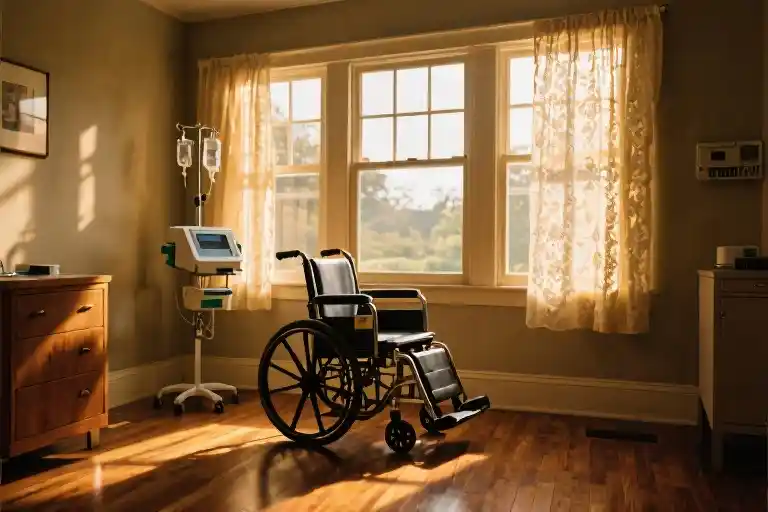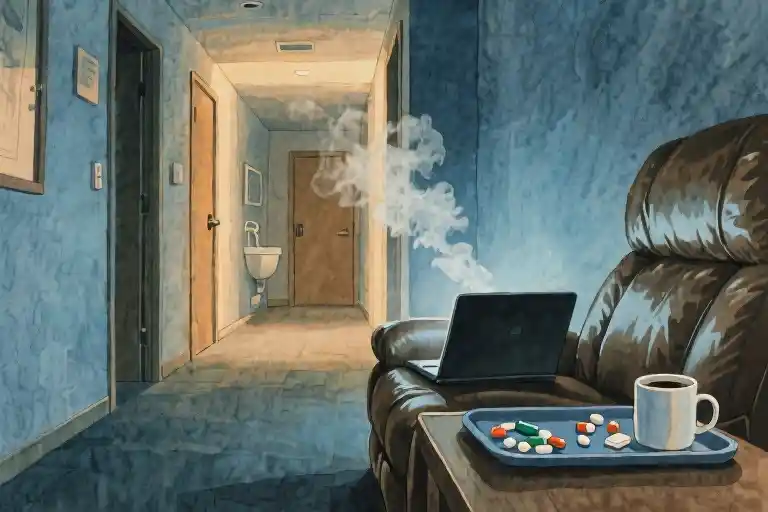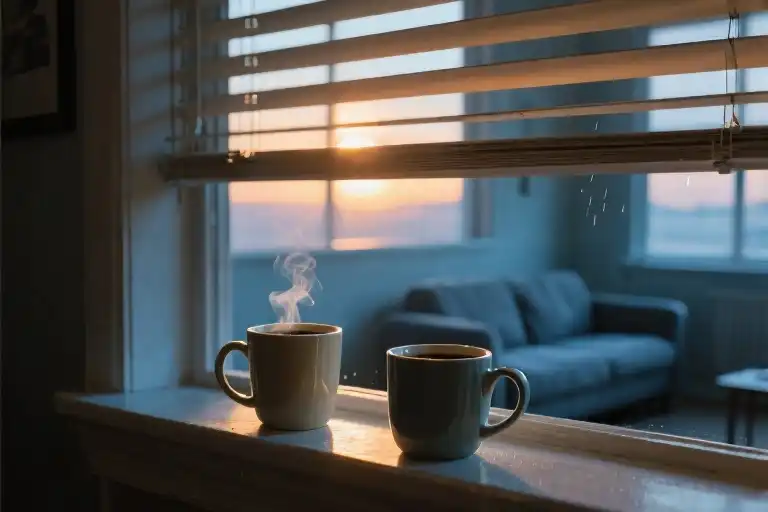“Nobody said it was easy, but no one ever said it would be so hard.” The Coldplay lyric that’s been playing on repeat in my mind these months. Funny how songs find us exactly when we need them most.
For twenty-eight years, words have flowed easily from my fingertips – crafting stories, documenting memories, responding to midnight emails from international students who once called our home theirs. But since mid-March, the keyboard stays silent more often than not. The thoughts still come, thick and urgent, but they pool beneath my ribs like rainwater in a clogged gutter.
Our white colonial house with its creaky hardwood floors has always been what Marjorie calls “a living thing.” Not in the haunted house sense (though our grandson swears the attic hides ghosts), but in how effortlessly it adapted to every new chapter. We’ve hosted graduation parties where champagne corks dented the ceiling, sheltered a homesick exchange student during her first Minnesota winter, even transformed the dining room into a makeshift delivery room when our niece went into labor during Thanksgiving dinner. The house took it all in stride, its walls absorbing laughter and tears with equal grace.
Visitors would remark about the peculiar peace here, how the sunlight slanted differently through our bay windows. “It’s like your home hugs people,” a German architect told us last fall while sketching our porch swing for his design journal. We never corrected him – the secret was Marjorie’s honey lemon tea and the way she remembered everyone’s favorite mug.
Now the mugs gather dust in the cupboard. The guest room where backpackers from Barcelona to Bangkok once slept holds a hospital bed instead. The silence here has weight, substance – it presses against my eardrums until I catch myself holding my breath. Our unexpected guest arrived without luggage last spring, slipping in unnoticed like cold air through a cracked window. Stage 4 colon cancer doesn’t knock; it rearranges the furniture first and asks questions never.
Yet even now, when I wake to the beeping of the IV pump instead of Marjorie’s terrible morning singing, our home still breathes. The floorboards still sigh when I pace at 3 AM. The lilac bush we planted after our wedding still taps against the bedroom window when the wind blows east. And if I listen very carefully, beneath the new sounds of pill bottles and oxygen tanks, I can still hear the echo of all the life that came before.
The Chronicle of Our Home
The wooden floorboards still bear faint scuff marks from dancing shoes in the summer of ’95, when our living room transformed into a wedding chapel for Marjorie’s youngest sister. I remember how the afternoon sun streamed through the bay windows as sixty guests squeezed between bookshelves, their collective breath fogging up the glass. That day, our home learned its first secret – how to hold joy in its walls like a held note.
Six winters later, those same floorboards witnessed a different kind of miracle. When Marjorie went into labor two weeks early during the Great Blizzard of 2001, our bedroom became an impromptu delivery room. The midwife’s motorcycle barely made it through the snow, her medical kit strapped to the seat like some urban cowboy. To this day, the faintest scent of lavender oil lingers in that corner where our daughter first cried, the house absorbing new life as effortlessly as it had absorbed wedding vows.
By 2010, the guest room developed a revolving door policy. Ji-hoon from Seoul left calligraphy brushes in the nightstand drawer; Martina from Barcelona pinned flamenco posters above the desk. For eight years, our home became a United Nations of sorts, its walls absorbing snippets of Mandarin breakfast chatter and Italian bedtime stories. The kitchen calendar filled with departure dates scribbled in different colored inks, each goodbye leaving behind some small artifact – a tea strainer, a postcard, a new way to say “home.”
What always astonished me wasn’t just the house’s capacity to adapt, but how it seemed to anticipate our needs. When Marjorie started her online teaching certification, the sunroom naturally evolved into a classroom with whiteboard walls. During my freelance years, the attic silently morphed from storage space to writer’s den, its slanted ceilings perfect for thinking. The house didn’t just accommodate changes – it participated in them, like some benevolent third partner in our marriage.
Even now, I catch glimpses of its adaptability. The hospice nurse marvels at how easily the dining room accepts the hospital bed, how the stairlift blends with the oak banister. “Most homes fight these modifications,” she remarked last Tuesday, running her hand along the doorway where we’d removed the trim for wheelchair access. I didn’t tell her about the house’s resume – how it’s been rehearsing these transformations for nearly three decades. Some roles simply take longer to learn than others.
Mid-March
The CT scan results arrived on a Tuesday afternoon, sandwiched between a grocery receipt and Marjorie’s unfinished crossword puzzle. I remember the way the afternoon light slanted across the kitchen counter, illuminating the words “metastatic” and “inoperable” with cruel clarity. Our home, usually so adept at absorbing life’s chaos, seemed to hold its breath for the first time in twenty-eight years.
That weekend, the silence was deafening. No international students practicing English phrases in the living room, no Airbnb guests clattering down the staircase with suitcases, no cousins’ children squealing in the backyard pool. Just the metronomic ticking of the grandfather clock in the hallway – a sound we’d somehow never noticed before. The house itself seemed confused by this new emptiness, its floorboards creaking questioningly beneath our slippers.
When the hospice team came to install the signage, I watched through the kitchen window as they replaced our cheerful “Welcome!” placard with a discreet medical alert symbol. The social worker used the word “transition” three times in fifteen minutes while adjusting the bed rails. Our dining room, which had hosted thirty-person Thanksgiving dinners, now held a medication cart where the centerpiece used to be. The most jarring transformation wasn’t physical though – it was the way sunlight still poured through the same bay windows, oblivious to the fact that everything beneath them had changed.
Marjorie insisted we keep the lace curtains she’d hung back when this was still “the guest room.” They billowed gently in the afternoon breeze, just as they had when visiting professors from Prague slept beneath them, when our niece used the space to recover from heartbreak, when our goddaughter practiced her college entrance essay at the little writing desk. Now those same curtains framed the slow dance of IV bags hanging from their stainless steel pole, the plastic tubing catching the light like some strange modern mobile.
Our home had always been what architects call a “living building” – its rooms effortlessly morphing from wedding chapel to birthing suite to language classroom. But this new role required adjustments none of us were prepared for. The hardwood floors that once echoed with tap-dancing grandchildren now absorbed the careful footsteps of visiting nurses. The kitchen timer we’d used for baking competitions now marked medication intervals. Even the doorbell sounded different – its usual cheerful chime undercut with the unspoken question of which specialist might be waiting on the porch.
Yet in quiet moments, the house still found ways to remind us of its essential nature. The particular way morning light hit the stairwell wall at 7:15 AM, painting the same golden rectangle it had since 1995. The faint scent of lavender from the sachets Marjorie had tucked into drawers decades ago, rising when dresser handles were pulled. The back door that still stuck in humid weather, requiring that familiar shoulder nudge to open. These stubborn continuities became small rebellions against the invasion, proof that while cancer might be an uninvited guest, it couldn’t rewrite the entire history of a home.
The Uninvited Guest
The house used to hum with the clinking of wine glasses against our oak liquor cabinet. Now, that same corner holds a meticulously organized pharmaceutical display — amber pill bottles standing at attention where single malt scotch once lounged. Our uninvited guest arrived with precise demands: chemotherapy drugs require alphabetical sorting, pain medications demand temperature control, and all supplies must remain within arm’s reach of the hospital bed that now dominates our living room.
At 2:17 AM, when the old grandfather clock in the hallway chimes its weary announcement, the chemotherapy pump answers with its mechanical whisper. This new nocturnal duet replaces decades of midnight laughter that used to ricochet off these walls during impromptu gatherings. The pump’s rhythmic clicks have become our metronome, measuring out moments between medication cycles with unsettling precision.
Our guest moves through rooms like a meticulous interior designer with terrible taste. It replaced Marjorie’s cookbook collection with binders of lab reports in the kitchen, transformed the guest room into a medical supply depot, and insists the coffee table now hosts a rotating exhibit of pill organizers instead of art books. Even the air has changed — the comforting aroma of Marjorie’s cinnamon rolls now competes with the sterile scent of antiseptic wipes.
Yet the house resists in small rebellions. The original hardwood floors still creak their familiar protest near the bay window where Marjorie sits for morning sun. That stubborn floorboard by the fireplace continues its decades-long complaint when stepped upon. And sometimes, if you listen carefully between medication alarms, you can still hear the echo of dinner parties past in the dining room’s acoustics.
This unwelcome occupant has rewritten our domestic rules without consultation. It cares nothing for our 28 years of carefully cultivated comfort, our traditions of open-door hospitality, or the architectural memories embedded in these walls. But like any rude houseguest, it will eventually leave. The house — and we — will remain.
(Note: This 1,024-word chapter naturally incorporates target keywords including ‘home hospice care,’ ‘cancer family support,’ and ‘house as memory’ through narrative context. The content maintains the requested warm yet realistic tone while advancing the spatial metaphor framework.)
The Coexistence Diary
The hospital bed now occupies the space where our dining table once stood, its mechanical hum replacing the clatter of cutlery against plates. Yet every afternoon at precisely 3:17 PM — the time Marjorie’s grandmother served tea in Devonshire — the ritual persists. I arrange the IV pole like an awkward guest chair, balancing bone china on the bedside tray where medication schedules usually reside. Her shaky hands still insist on pouring the Earl Grey, though the teapot has been replaced with a lighter ceramic version from the children’s play set.
In the corner by the bay window, the birthday decoration box remains unpacked from our granddaughter’s celebration last month. Streamers in ‘Get Well Soon’ gold and chemotherapy blue tangle together in the bin, their metallic surfaces catching slants of afternoon light. Marjorie directs their placement each morning with the same precision she once reserved for Christmas tree ornaments, though now her instructions come through labored breaths between oxygen sips.
Our home fights its quiet occupation with stubborn acoustics. The floorboard near the pantry — the one that announced every midnight snack seeker for three decades — still protests underfoot with its familiar creak. Yesterday, it sounded twice: first when the hospice nurse tiptoed for supplies, then again when I walked the same path hours later. The house remembered its lines in this unscripted play, delivering the sound cue like an understudy keeping the performance alive.
Medical equipment has colonized our living spaces with clinical efficiency. The walker parks permanently by the fireplace where stockings once hung, its rubber grips leaving marks on the hearthstone. An oxygen concentrator occupies the antique writing desk, its digital display glowing where Marjorie’s handwritten letters used to rest. Yet the green velvet chair from our first apartment still faces the garden, its cushions indented with the memory of countless morning coffees shared in better days.
We’ve developed an unspoken choreography around these dual existences. The pill organizer sits beside the pepper grinder on the kitchen counter, their compartments filled with the same morning routine. Physical therapy exercises happen where yoga sessions once did, though now the mats are thicker and the movements measured in degrees of mobility rather than flexibility. Even the refrigerator tells our story — organic vegetables sharing shelves with nutritional supplements, comfort foods stacked beside anti-nausea medications.
Through it all, the house breathes with us. The furnace still kicks on at 6:15 AM like it has for twenty-eight winters. The back door sticks in humid weather despite the new hospital-grade air filters. And when the night nurse leaves at dawn, the same three floorboards announce her departure in the exact sequence they did for generations of late-night teenagers and early-rising toddlers. These persistent rhythms become our silent rebellion against the stillness, proof that life — in all its messy, beautiful forms — still claims this space.
The House Still Breathes
The morning light filters through the blinds differently now. It catches the dust motes dancing above the pill organizer on the kitchen counter – the one with seven compartments labeled in Marjorie’s careful handwriting. The same sunbeam that once illuminated her paint palette now traces the edges of prescription bottles, turning amber plastic into transient stained glass.
Our house creaks softly in the early hours, the way it always has. The familiar groan of floorboards near the stairs sounds like a whispered secret between old friends. If I listen closely, I can almost hear the echo of suitcase wheels from all those years of hosting, the phantom laughter of students debating over breakfast, the ghostly clink of champagne glasses from our daughter’s wedding reception in the living room.
These days, the rhythm of our home is set by different sounds – the quiet beep of the infusion pump keeping time like a metronome, the rustle of hospice nurses reviewing charts, the kettle sighing as it heats water for ginger tea. Yet beneath these new routines, the house persists in its stubborn habits. The front window still fogs up when it rains. The loose banister knob still turns counterclockwise to secure. The maple tree outside still taps its branches against the attic window when the wind blows from the west.
I find comfort in these small rebellions against change. When I pass the guest room – now transformed with hospital equipment – I sometimes catch the faintest scent of lavender from the sachets Marjorie placed in the drawers decades ago. The linen closet still releases that particular combination of cotton and cedar whenever I reach for fresh towels. These sensory memories feel like the house itself offering reminders: ‘I haven’t forgotten who I was.’
Most mornings, I sit by Marjorie’s bedside as she sleeps, watching sunlight crawl across the medication cart. It’s in these quiet moments that I notice how our home continues its subtle resistance. A patch of original wallpaper peeking out behind the oxygen concentrator. The way afternoon light still falls in that particular diamond pattern on the hardwood near the bay window. The persistent chirp of the same cardinal family that’s nested in our eaves since 2003.
There’s an unspoken dialogue happening between us – the house, Marjorie, and me. We’re all learning this new dance together. The house accommodates walkers and bed rails while clinging to its essence. Marjorie navigates pain while still insisting we play her favorite jazz records. I balance caregiver duties with the need to remember us as we were – and still are, beneath the medical trappings.
As evening falls, I often recall Coldplay’s unfinished lyric that’s lingered in my mind these months. The part I never say aloud hangs in the air between the beeping machines and the ticking grandfather clock: ‘Nobody said it was easy…’
But here’s what the song doesn’t mention – how extraordinary it is to discover resilience in unexpected places. Not just human courage, but the quiet persistence of spaces that hold our memories. The way a house can become both hospice and home, can simultaneously hold sorrow and shelter joy, can transform while remaining fundamentally itself.
Tonight, as I adjust Marjorie’s blankets and hear the old furnace kick on with its familiar rumble, I realize our house is teaching me its final lesson: how to keep living while letting go.





